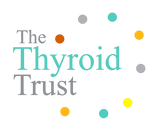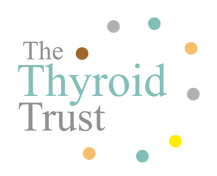 Written by Jenny Allen This blog describes Jenny Allen's personal experience with postpartum thyroiditis. Some readers may find it distressing. However, we recognise that not everyone will have similar symptoms or experience the same issues with diagnosis and treatment. Jenny Allen shares her brave story and battle with postpartum thyroiditis: “It took over 3 years of being horrendously unwell to find medical support for my not so common presentation of thyroiditis and this was because I was labelled and not heard." Postpartum thyroiditis
After giving birth I had what has been described as an ‘extreme presentation’ of postpartum thyroiditis – a condition where your thyroid becomes overactive and can return to normal or become underactive, usually at about 3 months postpartum. The beginning When I initially cried out for help, it was at my daughter’s injection appointment, and I was desperate for sleep – I had been wide awake for several consecutive nights even though my daughter slept through. A doctor was called, and, in a corridor, I was prescribed anti-depressants – this ‘diagnosis’ of mental health was my new label. One that remained a barrier to my care for over 3 years (and locally still does.) In crisis When the symptoms got worse, I was referred to a crisis mental health team. I screamed (literally) ‘this is not mental health – I feel like I am going to physically explode!’ I was prescribed anti-psychotic medication and told by the consultant who ‘popped in’ – ‘I’ve seen hundreds of women like you before.’ The label grew. Before I could commence the medication, bloods were requested, and the results showed an overactive thyroid. Overactive thyroid Often the overactive phase goes unnoticed but for me, it didn’t. For six weeks I was plagued by the excruciating feeling that was an overactive thyroid and for most of this time, I had no support or explanation for what was happening to me. I didn’t sleep for days, I constantly watched my own thoughts, experienced intense mood disturbances, paced, sweated and when it got too much, I banged my head against the wall for relief. There were times I felt like I couldn’t bear it any longer. Getting a diagnosis From this point forwards I read and learned about postpartum thyroiditis and a few weeks later, when my thyroid function became normal and then underactive, I was finally diagnosed. But this was not enough to shift the mental health label. Underactive thyroid As is the case with an underactive thyroid I was prescribed thyroxine but through lack of knowledge and understanding of the condition I was on and off this medication twice and before 12 months postpartum. Each time I stopped my debilitating symptoms returned but with my TSH (the thyroid function check) now in the normal range I had no obvious further options. Just keep going. Six consultant specialists instructed me to seek psychiatric help but with on-going symptoms, that I recognised as either an under or overactive thyroid I continued to research, share my story, and seek help. By this point I also had a very good counsellor, the isolation and lack of listening became impossible. The cycle of ill health For about a month or so I would feel ok (small reminders would tell me that it wasn’t done) then symptoms of what I recognised to be an overactive thyroid would explode back into my life preventing me from working and for a prolonged period of time accessing any quality of life. I would then feel excruciatingly tired, achy, miserable and physically unable to function for months and the cycle would begin again. This cycle infected every orifice of my life from work and finances to relationships, the health of my partner and how I cared for my daughter. Looking at the evidence I had a thyroid scan and amongst other findings it showed ‘acute thyroiditis,’ I have a family history of thyroid disease, I had symptoms that were the same as those experienced with a diagnosed thyroid problem (though this is not perceived as evidence in the way clinical tests are), I had a therapist who couldn’t diagnose within her field of expertise, I had raised antibodies but the gold standard TSH (Thyroid Stimulating Hormone) was normal. And so I was told that it was all in my head and excuses were made – ‘ of course, you will be tired with a young family.’ The label continued to grow. At each clinical interaction, the label festered and grew and along with it, my fear of not being heard. This fear sometimes presented itself and was then used as ‘evidence’ to compound my mental state – an easy get out when the answers aren’t obvious. What the professionals said And so, I was warned ‘not everything is your thyroid, you’re fixating on numbers, you don’t get a pain in your neck with thyroid illness, you’re taking up too much of my time and it looks like we have done enough for you.’ Giving up At this point I was ready to give up, to accept this was now my life and that I would just have to learn how to manage it. I didn’t know what was next. I had reached a dead-end and thought I had exhausted all options. Getting help I continued to share my story via a personal blog and in doing so was connected by The Thyroid Trust with a woman who had a similar experience 10 years prior. She kindly connected me with the consultant that had supported her. A few months later I was able to see him. I had time and space and was heard. He assessed all the evidence and gave weight to my symptoms – he listened. Diagnosis and support The diagnosis has been there all along, written in black and white, I have (Jenny’s) thyroiditis and thyroid disease. But now I also have medical intervention, support, and a plan which has recently resulted in total thyroidectomy - 5 years after the initial onset of postpartum thyroiditis. Looking forward I still have a journey to good health, but I am no longer on this journey alone and that is life changing. I try to focus my energies positively and look for opportunities in the big what if’s, but I sometimes can’t help but wonder. what if someone had listened sooner?” I have often heard postpartum thyroiditis described as uncommon; I think it more likely that too often it goes undiagnosed. Story taken from Jenny’s personal blog www.lifelovesandlearning.blog If you are concerned about any symptoms mentioned in Jenny’s article, please speak to your healthcare provider. Information on postpartum thyroiditis from www.nhs.co.uk: Postpartum thyroiditis is an uncommon condition that can affect women who have recently given birth. It's most common in women with type 1 diabetes and a previous history of postpartum thyroiditis. In postpartum thyroiditis, the immune system attacks the thyroid within around 6 months of giving birth. This causes a temporary rise in thyroid hormone levels (thyrotoxicosis) and symptoms of an overactive thyroid gland. Then, after a few weeks, the gland becomes depleted of thyroid hormone. This leads to low thyroid hormone levels and symptoms of an underactive thyroid gland. However, not every woman with postpartum thyroiditis will go through both these phases. If low thyroid hormone levels are causing severe symptoms medicine may be needed until the condition gets better. If high thyroid hormones are causing symptoms, beta blockers may provide relief. In most women, thyroid function returns to normal within 12 months of the birth, although low thyroid hormone levels can sometimes be permanent.
Kara
24/4/2024 07:34:24 pm
Hello there. My name is Kara I’m 35. I developed chronic Thyroiditis after catching covid 1.5 years ago. I’ve been plagued with mental health to the stage I couldn’t imagine it could be so bad. My thyroid flares and swells up during the time I feel hyperthyroid. Racing thoughts, I can’t think straight and I simply want to jump out my own skin. I developed intrusive thoughts and it’s gotten darker by the day. I paid privately which I couldn’t afford to see an endo as NHS waiting list took me off due to “normal levels” she diagnosed me with hashimotos. My heart rate is always above 100. And I ended up in a&e (again) due Comments are closed.
|
Thyroid FriendsThis blog is by members of Thyroid Trust Friends Network who have signed up to our Ground Rules and blogging guidelines. Please get in touch if you'd like to write something for possible publication on our site. Archives
June 2024
Categories
All
|
for everyone affected by thyroid diseaseMeetingsWe organise regular information and support meetings online and in person.
Click here for upcoming dates. We are a small independent charity. We receive no government funding and are reliant on donations for our income. Please support us.
PlEASE CONSIDER SUPPORTING OUR VITAL WORKThe donate button above takes you to a secure donation processing platform, JustGiving. Please contact us if you would prefer to make a direct bank transfer to donate via any other means, or if you are interested in volunteering.
|
|
Proud members of the following organisations
|
Proud to be in a charity partnership with:
|
With thanks to all our supporters, including:
|
Correspondence ADDRESS15 Great College Street, London, SW1P 3RX
The Thyroid Trust is also known as TTT and Thyroid Friends Network,
Registered Charity Number 1183292 Registered Address: 15 GREAT COLLEGE STREET, LONDON, SW1P 3RX Copyright asserted 2019 - Our consititution and all policy documents can be viewed on request. Read our Privacy Policy updated 23/5/18, . |

 RSS Feed
RSS Feed








